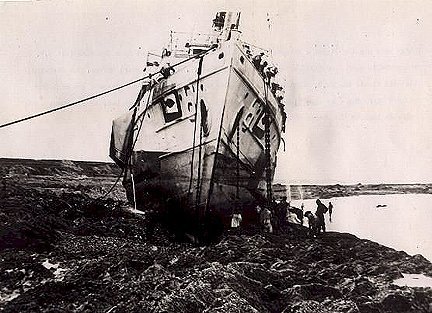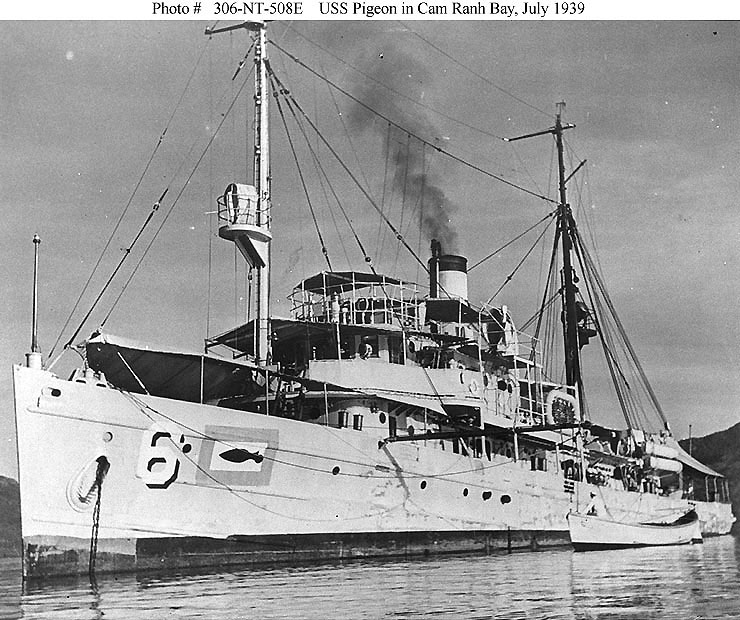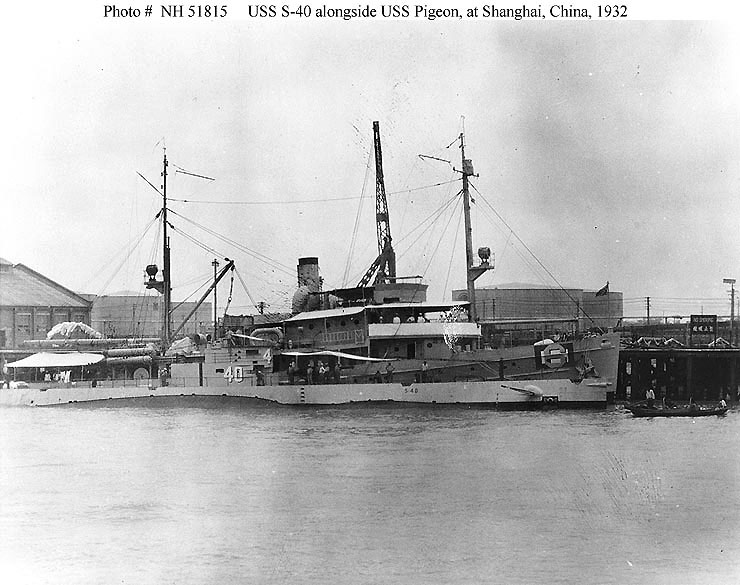United States Navy | ||||||||||||||||||||||||||||||
Submarine Tenders | ||||||||||||||||||||||||||||||
USS Pigeon | ||||||||||||||||||||||||||||||
 | ||||||||||||||||||||||||||||||
| USS Pigeon Having a not so great day. Typhoon driven wind and surf put her on the beach (thought to have happened sometime during the 1930s). She was re-floated and went on to serve her country proudly in some of this countries darkest moments... | ||||||||||||||||||||||||||||||
| ||||||||||||||||||||||||||||||
Webmaster's note: The Lapwing class of ships were small wooden-hulled general purpose ships built by the US at the ending of WWI. Because they were small, fast and versatile, the Navy used most as mine-sweepers - but a few were assigned other duties including Submarine Search and Rescue; and Tending Submarines. Most served their assigned tasks with quiet distinction. But world events would set certain ships - certain crews apart - as examples and inspiration to us all. So it is with the Pigeon. While not as well known as the Arizona or other familiar ships that were part of the start of WWII for the United States, the Pigeon and her crew earned a place of honor - an example to all of us - of what duty, tradition and honor are all about. The Pigeon's career as Submarine tender was short -- she had worked with submarines in various capacities from 1928 to 1941 - but she was a true submarine tender for only five months - "Hell in the Pacific"... That was all the time she had - and she - her crew - made the very most of it.The first Pigeon was laid down by the Baltimore Dry Dock and Shipbuilding Co., Baltimore, Md.; launched 29 January 1919; sponsored by Mrs. Joseph B. Provance; and commissioned in the Norfolk Navy Yard 15 July 1919, Lt. William C. Procknow in command. When hull classification symbols and numbers were assigned to ships 18 July 1920, Pigeon was designated AM-47. Pigeon departed Norfolk to serve the Pacific Mine Force at San Diego, Calif.; transited the Panama Canal 7 December 1919; and reached San Diego Christmas Eve. Pearl Harbor became her new base of operations 18 June 1920 and she decommissioned there 25 April 1922. Converted to a gunboat she recommissioned at Pearl Harbor 13 October 1923, Lt. Comdr. Elwin F. Cutts in command. Still classified a minesweeper, Pigeon departed Pearl Harbor 7 November 1923 and joined the Yangtze River Patrol Force at Shanghai, China 26 November 1923. For half a decade she served in the famous patrol protecting American citizens and commerce during the revolution that swept China. She began serving Submarine Division 16, U.S. Asiatic Fleet in September 1928. After ranging from the Philippines to the China coast, she fitted out as a "Submarine Salvage Vessel" at the Cavite Naval Station April-July 1929. She sailed from Manila Bay 13 July to cruise with Asiatic Fleet Submarines along the China coast until returning to Manila 11 September. The following day she was reclassified a Submarine Rescue Vessel (ASR-6). As a Submarine Rescue Vessel, Pigeon's primary mission was to salvage and aid submarines in distress. She had a complement of divers and was equipped with deep sea diving equipment. There was a McCann rescue chamber for rescuing men from sunken submarines. Pigeon also had a helium mixing tank for aiding divers in making deep dives. Her recompression chamber was a complete "divers hospital' to prevent the dreaded 'bends' in divers subjected to sudden ascents from deep depths. Pigeon continued duty with the Submarine Force of the Asiatic Fleet in waters ranging from the Philippines to the coast of China. She departed Shanghai for Manila 19 August 1940, arriving on the 24th, and remained in the Philippines as the Japanese gained control of the coastal ports of China. In November 1941 the 4th Marines evacuated Shanghai and ships of the Yangtze River patrol were withdrawn from China. Pigeon was one of the ships ordered to escort the American gunboats from Chinese waters. She departed Cavite for Formosa Straits 28-29 November 1941. Pigeon rendezvoused near midnight of 30 November-1 December 1941 with gunboats Luzon (PR-7), flagship gunboat Oahu (PR-6) and minesweeper Finch (AM-9). A Japanese seaplane circled the formation the morning of 1 December 1941. For about 8 hours, beginning at noon, seven Japanese warships encircled the American gunboats. One transport, loaded with troops (apparently bound for the Malayan expedition), held gunnery exercises on the gunboat formation. The episode ended about 1900 when a Japanese transport hoisted an International signal translated: "Enemy escaping on course 180(." On 4 December 1941 Pigeon sighted Corregidor Light and the convoy entered Manila Bay. On receiving word of the attack on Pearl Harbor, Lt. Comdr. Richard E. Hawes immediately prepared to get Pigeon underway and stood by to evacuate the Cavite Navy Yard. While waiting for the enemy to appear, he crammed the ship with stores and salvage and repair supplies and equipment. "Spittin" Dick Hawes had already become a legend among submariners. He had a reputation of superb loyalty to subordinates and was known for his ingenuity with men and the materials at hand. A special act of Congress elevated him to officer rank 18 February 1929 in recognition of his salvage feats on submarines S-51 and S-4. He had entered the Navy as a Fireman in 1917 and had earned the Navy Cross for distinguished service in salvaging Submarine S-51 during 1925-1926. He later served in several "S-boats" at the New London Submarine Base, became a Master Diver, then joined the staff of Submarine Division 4. He commanded submarine salvage ship Falcon from 1935 to 1938, served as Officer in Command of the Submarine Escape Training Tank at the Submarine Base in Hawaii, then took command of Pigeon 12 February 1940. Pigeon was moored in a five-ship nest at the Cavite Navy Yard 10 December 1941 when Japanese bombers launched massive raids. But Commander Hawes had relieving tackles rigged, steam at throttle, and men ready for action. His foresight saved Pigeon and submarine Seadragon - soon to become a tonnage champion of World War II. Pigeon's four machine guns - two .50 and two .30 caliber - were no match for Japan's high-altitude bombers, but she could outsmart them. She cleared the dock lashed to Quail (AM-15) then cut loose and both ships maneuvered clear of the bombs which fell close astern. Soon Cavite Navy Yard was engulfed in explosions and flames. In the nest which Pigeon had occupied lay submarine Sealion - her pressure hull pierced by bomb hits and beyond salvage; and Seadragon - damaged and without power to get underway. With them were minesweeper Bittern (AM-36) with a gasoline lighter as well as another lighter moored astern. While Pigeon maneuvered to save Seadragon, Machinist Rollin M. Reed and Watertender Wayne E. Taylor jumped in a surf boat to haul the burning lighter clear, got the gasoline lighter out of reach of flames, then assisted another small boat in hauling Bittern off the dock and to safety. Soon the flames and explosions reached the torpedo overhaul shop exploding torpedo warheads which hurled fiery missiles over Pigeon. Nevertheless, Pigeon calmly placed her stern across the end piling and ran a line some 20 feet to Seadragon and hauled the submarine clear of the dock. Seadragon's hull was already scorched from flames that swept the wharf. Just as Pigeon pulled the submarine backward to the channel, a big fuel tank exploded and spewed a horizontal wave of fire that blistered the hulls of both ships. Once Seadragon reached the channel, her skillful crew worked her out into the Bay. Her leaks were plugged and her pressure hull was patched by submarine tender Canopus (AS-9) when she departed for Soerabaja, Java, 16 December. Pigeon received the first Presidential Unit Citation awarded a ship of the United States Navy for her heroism in saving Seadragon. But Pigeon had "not yet begun to fight." By the end of the month her sailors had earned a second Presidential Unit Citation for fighting ability not expected of men in a little support craft. Lt. Comdr. Hawes reported: "The courage, spirit, and efficiency of the Pigeon crew is believed unsurpassed by past, present, or any future crews of any vessel of any nation." While the Navy Yard was still in flames, her crew was attempting to secure heavier armament for their ship. She armed herself with a 3-inch gun from fire-damaged Sealion (SS-195). Sheets of boiler plate were fashioned into gun and splinter shields for six .50 caliber machine guns which circled the bridge. "The Pigeon is well armed," wrote Hawes, "and is believed to be the best equipped vessel of her type and tonnage in existence." Not content to fend for herself, Pigeon worked tirelessly to help her sister ships and the other defenders of the Philippines. She replaced the 3-inch gun on minesweeper Tanager. She fed an average of 125 men daily, and salvaged valuable equipment from submarine Sealion. She also salvaged and transported deck loads of torpedoes to "Old Lady" Canopus to keep the Asiatic Fleet submarines armed. When Manila was declared an "open city", she towed Bittern to Mariveles. She made underwater repairs to submarine Porpoise, supplied submarine S-36 with both fresh and battery water; and towed all manner of supply-laden barges and small craft between Manila, Corregidor, Bataan, and Mariveles. She even charged air flasks for the torpedoes of PT Boats. During a bombing attack on Corregidor, her gunners blasted away at three twin-engined aircraft winging over the eastern end of the island. One exploded between Manja Island light and Corregidor, and the other two crashed just beyond the minefield. Pigeon scored again the following day when an enemy observation plane made the mistake of passing overhead, then turned back for a closer look. Shells from Pigeon ripped into the enemy aircraft which sideslipped, lost altitude, and headed out to sea. By the end of December, Manila Bay was no longer a suitable area for submarines. Only those just back from patrol remained. From these boats were evacuated the highly trained submariners to new Pacific bases in Java and Australia where they formed the nucleus maintenance crews that kept the American submarine forces on patrol. On 5 January 1942, Lt. Comdr. Hawes turned over command of Pigeon to Lt. Comdr. Frank Alfred Davis, USNR, and became first lieutenant of submarine tender Holland. Under Davis, another leader of heroic stock, Pigeon continued her fearless struggle. Since Japanese warships outside Manila Bay made it impossible for her to escape, Pigeon remained behind with Canopus, a few old gunboats, and small craft to fight with the Army of Bataan. She again fought off enemy aircraft, towed between Mariveles and Corregidor; conducted diving operations for salvage, scuttled equipment and destroyed munitions that might fall to the enemy; and established a lookout station at Gorda Point, Bataan. On the night of 5 January 1942, she slipped off Japanese occupied Sangley Point, Cavite, and snatched a barge of submarine mines from under the nose of the enemy. Men armed to the teeth stepped quickly and quietly from a whaleboat, made a towline fast, and returned to Pigeon. As an added act of defiance the landing party ignited several barrels of aviation gasoline. Pigeon kept up her energetic pace of support in the Philippines defense. In February 1942 she deprived the enemy of two ammunition lighters and salvaged some 160,000 gallons of fuel oil from merchantman S. S. Don Jose enabling gunboats to stay on patrol She also repelled 6 enemy dive bombers, knocking down one and crippling another which later crashed on Bataan. She set up a repair base at Saseaman Dock, using a submarine barge to tend small craft of the inshore patrol and for Philippine "Q" boats." She also fueled a submarine at South Dock, Corregidor. In March 1942, Pigeon salvaged and concealed gasoline drums ashore in Saseaman Cove, fueled a submarine and gunboats, and towed several lighters between Corregidor and Baatan. She also salvaged and repaired S.S. Floricita and towed her from the beach at Corregidor to Mariveles. In April she dueled with enemy artillery at Cab Cabin and again fought off enemy aircraft. Bataan fell on 9 April 1942 and, rather than surrender to the enemy, Canopus backed away from the dock and sank at the hands of her own crew. That night Pigeon made rendezvous with fleet submarine Snapper under the enemy guns in the south channel off Corregidor. Snapper had brought 45 tons of food and stores for beleaguered Corregidor and Pigeon hurried to load the cargo before the start of night bombing raids. After the fall of Bataan, Pigeon's crew spent the days on shore and returned to their ship for night operations that included dumping Philippine currency in the channel south of Corregidor. She continued to serve until the afternoon of 4 May 1942 when a bomb from a dive bomber exploded on her starboard quarter. She sank in eight minutes but her crew was on shore. The Japanese later captured these brave sailors but many survived the war. Lt. Comdr. Frank Alfred Davis carried on the fighting tradition and valor of his command while interned at the infamous prisoner-of-war camp at Cabanatuan, Philippine Islands. He built a powerful underground organization to obtain food, medicines and communications of all kinds. He volunteered for command of a firewood detail, and despite the constant surveillance of Japanese guards, succeeded in smuggling into camp tremendous amounts of food and other necessities to his fellow prisoners. His great personal valor and grave concern for others at a great risk to his own life contributed to the welfare and morale of all prisoners on Luzon and saved countless lives before he died 14 December 1944. Lt. Comdr. Davis received the Navy Cross for his intrepid fight on Canopus and Pigeon and was posthumously awarded the Legion of Merit for his courageous and dedicated service to fellow prisoners. Pigeon received one battle star and two Presidential Unit Citations for service during World War II. History from the Dictionary of American Fighting Ships. | ||||||||||||||||||||||||||||||
 |
||||||||||||||||||||||||||||||
|
|
||||||||||||||||||||||||||||||
 |
||||||||||||||||||||||||||||||
|
|
||||||||||||||||||||||||||||||
| USS Coucal | ||||||||||||||||||||||||||||||
| Table of Ships | ||||||||||||||||||||||||||||||
| Go to TenderTale Main Page | ||||||||||||||||||||||||||||||
| © 1997, 2006 & 2011 Common Cents Computers |